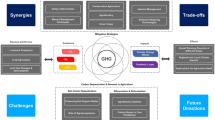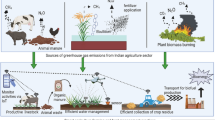
Overview
- Provides guidelines for low-cost assessment of greenhouse gas emissions in smallholder farming systems
- Discusses methods for assessing economic and social acceptability of climate change mitigation measures?
- Will bring attention attention to trade-offs between carbon sequestration, farmers income, and other social outcomes
Buy print copy
Tax calculation will be finalised at checkout
About this book
This book provides standards and guidelines for quantifying greenhouse gas emissions and removals in smallholder agricultural systems and comparing options for climate change mitigation based on emission reductions and livelihood trade-offs. Globally, agriculture is directly responsible for about 11% of annual greenhouse gas (GHG) emissions and induces an additional 17% through land use change, mostly in developing countries. Farms in the developing countries of sub-Saharan Africa and Asia are predominately managed by smallholders, with 80% of land holdings smaller than ten hectares. However, little to no information exists on greenhouse gas emissions and mitigation potentials in smallholder agriculture. Greenhouse gas measurements in agriculture are expensive, time consuming, and error prone, challenges only exacerbated by the heterogeneity of smallholder systems and landscapes. Concerns over methodological rigor, measurement costs, and the diversity of approaches, coupled with the demand for robust information suggest it is germane for the scientific community to establish standards of measurements for quantifying GHG emissions from smallholder agriculture. Standard guidelines for use by scientists, development organizations will help generate reliable data on emissions baselines and allow rigorous comparisons of mitigation options. The guidelines described in this book, developed by the CGIAR Research Program on Climate Change, Agriculture, and Food Security (CCAFS) and partners, are intended to inform anyone conducting field measurements of agricultural greenhouse gas sources and sinks, especially to develop IPCC Tier 2 emission factors or to compare mitigation options in smallholder systems.
Similar content being viewed by others
Keywords
Table of contents (10 chapters)
-
Front Matter
-
Back Matter
Editors and Affiliations
About the editors
Dr. Meryl Richards is an agroecologist who joined the Research Program on Climate Change, Agriculture and Food Security (CCAFS) in January 2013 as a Science Officer for Theme 3: Pro-Poor Climate Change Mitigation. Her research experience and interests center around synergies and trade-offs between food security and environmental conservation in smallholder agriculture, as well as measurement of GHG emissions from agriculture. She has a particular interest in agroforestry systems and has conducted research in Central America and West Africa.
Dr. Marina Rufino is a SeniorScientist and team leader at Forest and Environment, Center forInternational Forestry Research (CIFOR) in Indonesia. Dr. Lini Wollenberg is Research Associate Professor at the Gund Institute for Ecological Economics and Rubenstein School of Environment and Natural Resources, University of Vermont. She was previously the Director of the Center for Sustainable Agriculture, U. of Vermont (2007-2009); Principle Scientist at the Center for International Forestry Research (1994-2005); and Program Officer for Asia’s Rural Poverty and Resources Program at the Ford Foundation (1991-1994).
Dr. Eva Wollenberg is currently Flagship Leader for Low Emissions Agriculture for CCAFS and Research Associate Professor at the Gund Institute for Ecological Economics and Rubenstein School of Environment and Natural Resources, University of Vermont. She was previously the Director of the Center for Sustainable Agriculture, U. of Vermont (2007-2009); Principle Scientist atthe Center for International Forestry Research (1994- 2005); and Program Officer for Asia’s Rural Poverty and Resources Program at the Ford Foundation (1991-1994).
Bibliographic Information
Book Title: Methods for Measuring Greenhouse Gas Balances and Evaluating Mitigation Options in Smallholder Agriculture
Editors: Todd S. Rosenstock, Mariana C. Rufino, Klaus Butterbach-Bahl, Lini Wollenberg, Meryl Richards
DOI: https://doi.org/10.1007/978-3-319-29794-1
Publisher: Springer Cham
eBook Packages: Biomedical and Life Sciences, Biomedical and Life Sciences (R0)
Copyright Information: The Editor(s) (if applicable) and the Author(s) 2016
Hardcover ISBN: 978-3-319-29792-7Published: 31 August 2016
Softcover ISBN: 978-3-319-80656-3Published: 22 April 2018
eBook ISBN: 978-3-319-29794-1Published: 23 August 2016
Edition Number: 1
Number of Pages: XV, 203
Number of Illustrations: 6 b/w illustrations, 27 illustrations in colour
Topics: Agriculture, Climate Change, Atmospheric Protection/Air Quality Control/Air Pollution, Soil Science & Conservation, Environmental Management



